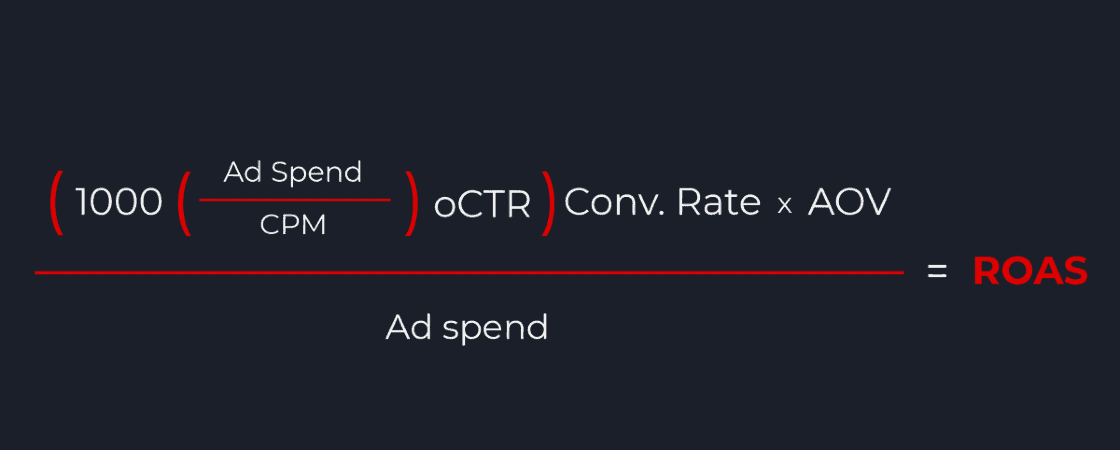
Understanding ROAS: Introducing Clarity to a Simple Metric
Our expanded ROAS formula helps provide a more complete understanding of the variables that go into your ad performance. Here's how to use it.
ROAS is the most commonly measured metric of success for ecommerce companies, but the general understanding of ROAS is woefully incomplete. Ad-attributed revenue divided by ad spend equals ROAS. It’s a simple formula that provides a good but somewhat simplistic understanding of your advertising’s effectiveness.
But what about the variables that go into revenue? By expanding the revenue equation, a better picture of performance emerges and how a number of metrics work with each other.
Let’s take a look.
Expanding the ROAS Equation
I want to start by giving some credit to Taylor Holiday at Common Thread Collective for the basic formula expansion for revenue. They have been big believers in the basic formula of visitors * conversion rate * AOV = Revenue. This is a great formula for understanding how conversion rate and AOV impact revenue. But it obscures the variables that are integral to calculating visitors. In the case of visitors that arrive through digital advertising, I feel that this simplification is detrimental to our understanding of performance.
If we take this basic revenue formula and expand it out to be inclusive of variables on the ad platform side, we get a much deeper understanding of where our ROAS number comes from, how we can control it, and how small changes in individual variables can have a major impact on ROAS and profitability.
The expanded formula is:
((1,000(Ad Spend/CPM)*oCTR)* Conversion Rate * AOV)/ad spend=ROAS

Let’s dive into the equation.
Breaking Down the Equation
The equation looks more complex than it is. We have 5 variables which are:
- Ad Spend
- Cost per Thousand Impressions (CPM)
- Outbound Clickthrough Rate (oCTR)
- Conversion Rate
- Average Order Value (AOV)
These variables each play a role in our ROAS calculation. By expanding the equation to include these variables, we can make smarter optimizations and create projections for how improving certain performance like conversion rate impact our profitability.
Ad Spend
The ad spend component is self explanatory. It is the amount you are spending on any CPM based digital ad platform. This can be a blend if you want to look at multiple platforms together like Facebook and Snap, or it can be on a per platform basis. In order to reach a ROAS number we need the AS.
oCTR
The simplified version of this formula looks at visitors, conversion rate, and AOV. One of the critical variables influencing the number of website visitors is your oCTR. This variable is primarily influenced by the quality of creative, offer, and copy. A better oCTR means more visitors for the same amount of money.
Conversion Rate
How many visitors are you converting to customers? It’s important. In fact, I would argue that conversion rate is the most important metric when determining the success of not just digital advertising but of an ecommerce business in general. How well your website converts impacts all your traffic sources, not just paid advertising.
Average Order Value
If your AOV is $100, you’re able to have much softer metrics elsewhere than if your AOV is $20. AOV is heavily dependent on your vertical, and you won’t be able to take a $20 AOV and make it $100, but small changes by introducing upsells, bundles and things like that can increase your AOV.
Cost per Thousand Impressions (CPM)
The reason I built out this entire equation is CPM. Lots of smaller advertisers we work with are seeing truly outrageous CPMs, and I wanted a way to demonstrate the performance metrics we need in order to achieve certain levels of success. This is the variable we have little to no control over, but it is critical to whether or not we can achieve success with our advertising.
Using the eROAS Equation
Before we talk about using the expanded ROAS equation to influence your ecommerce advertising, it is important to note some of its limitations.
First, we are getting less data than ever from Facebook and other ad platforms. With tighter privacy laws and actions taken by companies like Apple, our ability to directly attribute revenue back to ads is weaker than ever before. As such, it is important to use the formula as a means of understanding the relationship between the variables and not as a locked-in rule for your analysis.
Second, this formula only works for CPM based advertising. We can modify the formula to work for CPC-based advertising like Google, but that will be saved for a different post.
The Equation in Action
I think the equation is much easier to understand when we look at it in action. So let’s walk through an example.
Let’s look at a pretty simple baseline of metrics. We have a CPM of $15. Our oCTR is 2% and we have a conversion rate of 2.5%. Our AOV is $55, and we’re spending $10,000 on ads.

With those metrics, our ROAS is 1.83. That’s not great, but it’s not terrible either. Depending on the business it might be marginally profitable. But it’s realistic and something that we can work to improve on.
Now let’s change that CPM to $50. We’ve been working with a number of clients who are seeing CPMs on Facebook of $50 or more. Our ROAS is now 0.55, and we’re absolutely lighting money on fire.

Let’s say we want to get back to that 1.83 in a $50 CPM environment. There are a number of ways we can get there since we have different variables, but for this example let’s look at isolating the conversion.
We can modify the formula to isolate conversion rate. Our formula becomes:
(ROAS*Ad Spend)/((Ad Spend/CPM)*1000*AOV*oCTR)= Conversion Rate.

In order to achieve that 1.83 when the CPM is $50 our conversion rate needs to be 8.3%. If we want to achieve a 2.5x ROAS with a CPM of $50, our conversion rate needs to be 11.36%!
As you can see in this example, a high cost of traffic impacts the other performance metrics you need to achieve in order to be successful.
How Small Changes Impact Performance
One of the most exciting uses for this equation is showing how small improvements to these key variables can result in big profitability gains for your business.
Let’s take the baseline from our previous example again. CPM of $15, oCTR of 2%, conversion rate of 2.5%, and an AOV of $55 resulting in our 1.83x ROAS.
Now let’s make some small improvements to our variables. We make some better creative and our oCTR nudges up to 2.2%. And with some CRO changes on the website we see our conversion rate rise to 2.7%. We also add some post purchase upselling and introduce bundles and see a modest increase in AOV to $58.

That 1.83x is now a 2.30x! That’s a 26% increase in ROAS from small improvements across the board. Incremental improvements can be transformative, and that is really exciting!
Applying the Equation to Your Business
How can you apply this equation to your business? Two ways to use it is as a diagnostic tool and a projection tool.
I think the most important way to use it is as a diagnostic tool to see if you can even be successful with Facebook ads in the first place. If you’ve started running Facebook ads, you can take your CPM and your AOV and figure out what combination of oCTR and conversion rate you need to achieve to be profitable.
Both CPM and AOV are relatively static numbers. If your AOV is $20 you might be able to increase it to $23 or $25, but you’re not going to be able to double it. You also don’t have much control over your Facebook CPM. After inputting your AOV and the CPM you’ve been getting, you can see what you need to achieve in terms of conversion rate and oCTR to reach your target ROAS. Is it realistic or absurd? Maybe Facebook advertising just can’t work for your business, and it is time to find other advertising channels.
It is also extremely helpful for projections. If you’re working on CRO and you’re projecting that your conversion rate will increase half a percent, you can include that projection in the formula and see how it impacts your ROAS.
Likewise, if you’re getting new creative developed that you think will increase your oCTR or you’re starting to experiment with upsells and bundles that will increase your AOV, you can project how those changes will impact your ROAS.
With this equation, you’re able to create a range of projections for how your business will perform.
You’re also able to see how long the payback period is on investments as well! Let’s look at an example of this in action.
Let’s say you’re looking to improve the speed of your Shopify store, and it will cost $2,000 to get that work done. You project that it will increase your conversion rate by 0.25% .
We will use all the baselines from the previous examples and nudge conversion rate to 2.75%. The 1.83 ROAS turns into 2.02, an improvement of 0.19. If you multiply your ad spend by the ROAS improvement– 0.19 in this case– we get $1,900. So if we get the performance improvement we expect, the payback period for this investment is one month. That sounds like a great investment to me!
eROAS Calculator
Running the math on your own can be annoying. So we’ve built an eROAS calculator that you can use to find your ROAS, and see how changes in your metrics will impact ROAS. Head on over here to check out the ROAS calculator.
Instructions on how to use the calculator can also be found on the calculator page as well.
Final Thoughts
The expanded ROAS equation is a great tool to add to your toolbox whether you’re a brand looking to better understand your numbers and project future performance or an agency/freelancer looking to step up your game for clients.
Digital advertising has never been more expensive or competitive than it is today, and it is critical to understand how our numbers impact our results. Without a complete understanding, we are truly flying blind.
If you have any questions about the equation and its applications, feel free to email me at collin@taikundigital.com or reach me on Twitter @cjslattery. And if you’re looking to work with an agency that understands the numbers, get in touch to see if we’re a good fit.
Related Articles

- Paid Social
Found a Winning Ad? Here’s How to Iterate on It Properly
Let’s say you’ve finally cracked it. You launched a new concept, and it’s outperforming everything else in your account. ROAS is…

- Paid Social
5 Learnings From Auditing Dozens of Meta Ad Accounts
At Taikun, we’ve audited dozens of Meta ad accounts in the past few months. The brands varied, but the patterns were…

- Paid Social
The 3 Creative Brief Mistakes That Quietly Kill Ad Performance
At this stage, you’ve likely got your media buying dialed in. You’re testing hooks, angles, creative formats. You’re launching weekly. But…
How can we help you grow?



